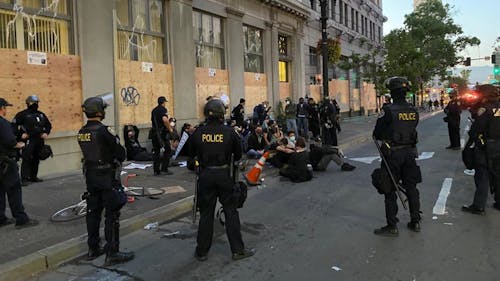Settlement: Police in Calif. City, County Can’t Fire Projectiles into Crowds

Oakland CA Sept 3 2022
Oakland police and Alameda County sheriff’s officers, who have injured protesters in the past with rubber-tipped bullets and other so-called less-lethal munitions, have consented to a settlement largely prohibiting them from firing projectiles or explosive devices into crowds.
The settlement, to be enforced by a federal magistrate for the next five years, also includes $125,000 in payments to each of two demonstrators who were shot with rubber bullets by sheriff’s deputies in June 2020 during an Oakland protest over the killing of George Floyd by police in Minneapolis.
A state law that took effect this year, AB48, allows police to use projectiles or chemical weapons only when necessary to save lives, prevent serious injuries or bring dangerous situations under control, and requires officers to issue repeated warnings before using the weapons.
The settlement goes further, attorney Rachel Lederman said Thursday: It prohibits virtually all use of such munitions on crowds, allowing them only when an officer has a clear shot at an individual who poses an immediate threat of death or great bodily injury. It applies to flash-bang grenades, which are not covered by AB48. It specifies that a protester’s act of picking up and throwing an object, like a chemical canister fired by police, does not justify firing munitions at the protester. And it also protects non-political gatherings, like crowds after sporting events.
“No one should risk devastating injuries to protest for social justice,” Lederman said.
She said Oakland first agreed to restrictions on police use of rubber bullets and other projectiles after its officers injured more than 50 people in 2003 during protests against the U.S. war in Iraq. “But every time there’s a resurgence of large demonstrations, Oakland violates that agreement,” Lederman said.
Scott Olsen, an Iraq War veteran, was shot in the head by a police “beanbag,” or cloth-covered lead pellet, suffered brain damage and nearly died while taking part in an Occupy Oakland protest against police in 2011. The city paid $4.5 million to settle his case, and paid $1.17 million to a dozen protesters who were wounded on the same day.
At the June 2020 protest over Floyd’s killing, lawyers said, when officers started tear-gassing the demonstrators, Tosh Sears turned to leave, but was shot in the hip with a pellet by a sheriff’s deputy. Another protester, Kierra Brown, was helping other protesters wash the chemical out of their eyes when officers charged at her. She tried to run in the direction they were indicating, and a deputy shot her in the calf, lawyers said. Each will receive $125,000 under the settlement.
“I felt like a target in my own city, at the hands of people who are supposed to protect me,” Sears, 52, a delivery driver, said in a statement released by his lawyers.
“Just seeing the way that the officers treated unarmed, innocent people was deeply painful,” said Brown, a 22-year-old legal worker. “And that fear has never left me.”
Lederman, their lead attorney, said the Oakland Police Department already has a policy that is supposed to prohibit most of the conduct barred by the court settlement. But she said the 2020 protest showed that police were prepared to either disregard their policy or invite the sheriff’s office, which has no such internal restrictions, to join them at local demonstrations.’
In response, the Police Department said Thursday it “is currently updating policies to comply with the requirements of the settlement agreement with the city of Oakland, as well as ensuring we are abiding by AB48.”



